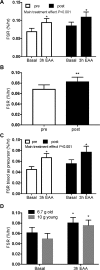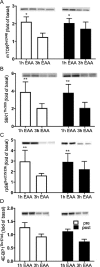Muscle Protein Anabolic Resistance to Essential Amino Acids Does Not Occur in Healthy Older Adults Before or After Resistance Exercise Training
- PMID: 29796648
- PMCID: PMC6251608
- DOI: 10.1093/jn/nxy064
Muscle Protein Anabolic Resistance to Essential Amino Acids Does Not Occur in Healthy Older Adults Before or After Resistance Exercise Training
Erratum in
-
Erratum.J Nutr. 2018 Oct 1;148(10):1699. doi: 10.1093/jn/nxy181. J Nutr. 2018. PMID: 30281119 Free PMC article. No abstract available.
Abstract
Background: The muscle protein anabolic response to contraction and feeding may be blunted in older adults. Acute bouts of exercise can improve the ability of amino acids to stimulate muscle protein synthesis (MPS) by activating mechanistic target of rapamycin complex 1 (mTORC1) signaling, but it is not known whether exercise training may improve muscle sensitivity to amino acid availability.
Objective: The aim of this study was to determine if muscle protein anabolism is resistant to essential amino acids (EAAs) and whether resistance exercise training (RET) improves muscle sensitivity to EAA in healthy older adults.
Methods: In a longitudinal study, 19 healthy older adults [mean ± SD age: 71 ± 4 y body mass index (kg/m2): 28 ± 3] were trained for 12 wk with a whole-body program of progressive RET (60-75% 1-repetition maximum). Body composition, strength, and metabolic health were measured pre- and posttraining. We also performed stable isotope infusion experiments with muscle biopsies pre- and posttraining to measure MPS and markers of amino acid sensing in the basal state and in response to 6.8 g of EAA ingestion.
Results: RET increased muscle strength by 16%, lean mass by 2%, and muscle cross-sectional area by 27% in healthy older adults (P < 0.05). MPS and mTORC1 signaling (i.e., phosphorylation status of protein kinase B, 4E binding protein 1, 70-kDa S6 protein kinase, and ribosomal protein S6) increased after EAA ingestion (P < 0.05) pre- and posttraining. RET increased basal MPS by 36% (P < 0.05); however, RET did not affect the response of MPS and mTORC1 signaling to EAA ingestion.
Conclusion: RET increases strength and basal MPS, promoting hypertrophy in healthy older adults. In these subjects, a small dose of EAAs stimulates muscle mTORC1 signaling and MPS, and this response to EAAs does not improve after RET. Our data indicate that anabolic resistance to amino acids may not be a problem in healthy older adults. This trial was registered at www.clinicaltrials.gov as NCT02999802.
Figures






Similar articles
-
Anabolic Sensitivity in Healthy, Lean, Older Men Is Associated With Higher Expression of Amino Acid Sensors and mTORC1 Activators Compared to Young.J Cachexia Sarcopenia Muscle. 2025 Feb;16(1):e13613. doi: 10.1002/jcsm.13613. Epub 2024 Nov 19. J Cachexia Sarcopenia Muscle. 2025. PMID: 39558870 Free PMC article.
-
Bed rest impairs skeletal muscle amino acid transporter expression, mTORC1 signaling, and protein synthesis in response to essential amino acids in older adults.Am J Physiol Endocrinol Metab. 2012 May 15;302(9):E1113-22. doi: 10.1152/ajpendo.00603.2011. Epub 2012 Feb 14. Am J Physiol Endocrinol Metab. 2012. PMID: 22338078 Free PMC article.
-
Free essential amino acid feeding improves endurance during resistance training via DRP1-dependent mitochondrial remodelling.J Cachexia Sarcopenia Muscle. 2024 Oct;15(5):1651-1663. doi: 10.1002/jcsm.13519. Epub 2024 Jun 16. J Cachexia Sarcopenia Muscle. 2024. PMID: 38881251 Free PMC article.
-
Exercise, amino acids, and aging in the control of human muscle protein synthesis.Med Sci Sports Exerc. 2011 Dec;43(12):2249-58. doi: 10.1249/MSS.0b013e318223b037. Med Sci Sports Exerc. 2011. PMID: 21606874 Free PMC article. Review.
-
Muscle Protein Synthesis and Whole-Body Protein Turnover Responses to Ingesting Essential Amino Acids, Intact Protein, and Protein-Containing Mixed Meals with Considerations for Energy Deficit.Nutrients. 2020 Aug 15;12(8):2457. doi: 10.3390/nu12082457. Nutrients. 2020. PMID: 32824200 Free PMC article. Review.
Cited by
-
Moderate-intensity aerobic exercise improves skeletal muscle quality in older adults.Transl Sports Med. 2019 Apr;2(3):109-119. doi: 10.1002/tsm2.70. Epub 2019 Feb 20. Transl Sports Med. 2019. PMID: 31123725 Free PMC article.
-
Protein Requirements for Master Athletes: Just Older Versions of Their Younger Selves.Sports Med. 2021 Sep;51(Suppl 1):13-30. doi: 10.1007/s40279-021-01510-0. Epub 2021 Sep 13. Sports Med. 2021. PMID: 34515969 Free PMC article. Review.
-
Anabolic Sensitivity in Healthy, Lean, Older Men Is Associated With Higher Expression of Amino Acid Sensors and mTORC1 Activators Compared to Young.J Cachexia Sarcopenia Muscle. 2025 Feb;16(1):e13613. doi: 10.1002/jcsm.13613. Epub 2024 Nov 19. J Cachexia Sarcopenia Muscle. 2025. PMID: 39558870 Free PMC article.
-
Novel individualized power training protocol preserves physical function in adult and older mice.Geroscience. 2019 Apr;41(2):165-183. doi: 10.1007/s11357-019-00069-z. Epub 2019 May 10. Geroscience. 2019. PMID: 31076998 Free PMC article.
-
Muscle from aged rats is resistant to mechanotherapy during atrophy and reloading.Geroscience. 2021 Feb;43(1):65-83. doi: 10.1007/s11357-020-00215-y. Epub 2020 Jun 25. Geroscience. 2021. PMID: 32588343 Free PMC article.
References
-
- Newman AB, Kupelian V, Visser M, Simonsick EM, Goodpaster BH, Kritchevsky SB, Tylavsky FA, Rubin SM, Harris TB. Strength, but not muscle mass, is associated with mortality in the Health, Aging and Body Composition Study cohort. J Gerontol A Biol Sci Med Sci 2006;61:72–7. - PubMed
Publication types
MeSH terms
Substances
Associated data
Grants and funding
LinkOut - more resources
Full Text Sources
Other Literature Sources
Medical
Research Materials

